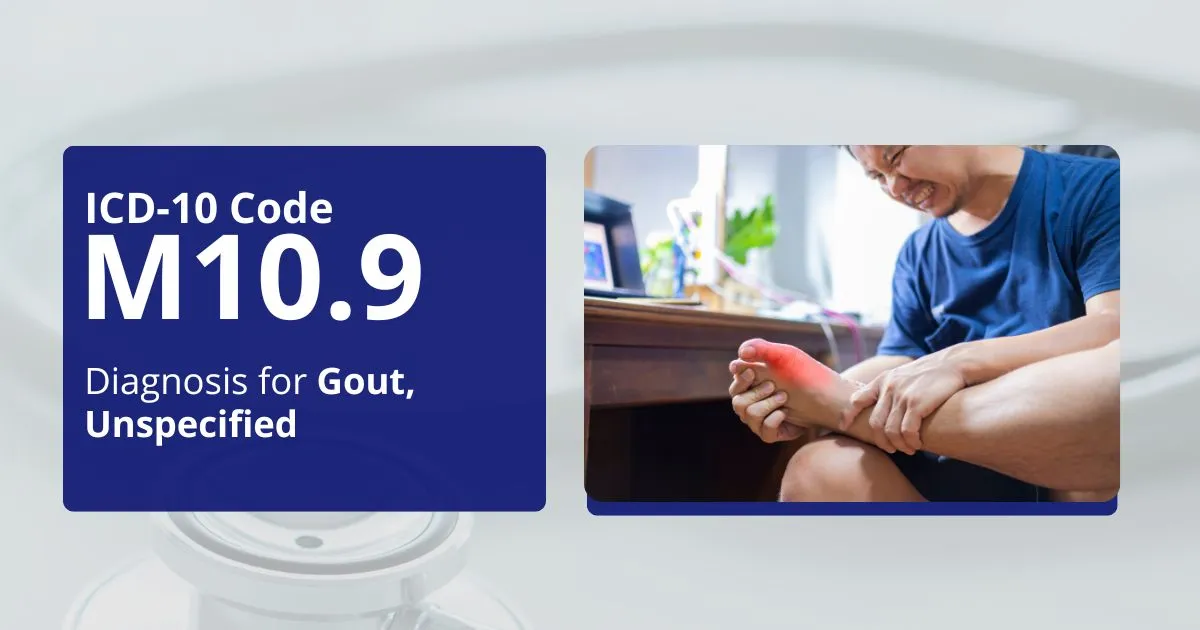ICD-10 code M10.9 is a billable diagnosis code used for reimbursement of Gout, Unspecified, or when gout is present but the specific type or location is not documented.
Among the new codes introduced in 2025 is ICD-10 code M10.9. This code is applied in situations where the doctor’s notes are unclear about where the gout is or how it was caused.
Did you know that the changes in documenting and coding gout within healthcare practices started with the 2025 ICD-10-CM coding system implementation on October 1, 2024?
These changes are just to make sure that your practice receives reimbursement on time, remains compliant with healthcare rules, and provides optimal care.
In this article, our main focus is on the need to change your gout ICD-10 coding for 2025 and the processes involved in implementing the necessary changes.
Why is Accurate Gout ICD-10 Coding Important?
Gout is the most common type of arthritis. But with painful, red, hot, swollen joints. It mostly affects the sickness of your big toe. It occurs due to excessive uric acid buildup in the body. Uric acid forms sharp crystals in joints that lead to inflammation and pain, which, left untreated, will damage the joints.
So, proper documentation for ICD-10 for gouty arthritis is important for many reasons; some important ones are as follows;
Getting Paid
Insurance companies rely on coding procedures and reimburse their clients based on submitted codes. Proper codes will streamline payment and enhance financial inflow to your practice.
Keeping Up
The rules and regulations in healthcare are always changing. The accurate coding of chronic gout ICD-10 helps your practice avoid fines and audits.
More Patient Care
The right coding enables physicians to monitor the patient’s disease progression. Thus, better treatment decisions can be made, and care is more precise.
What’s New in Gout Coding for 2025?
Under the 2025 ICD-10-CM update, coding of gout has changed significantly. Let’s see the greatest changes that will affect your work.
1- Finer Codes for Some Joints
Before, there was no specific ICD-10 gout code M10.9; there was just a general code for gout. However, after the 2025 update, a code indicates which specific joint is affected by gout. This helps the physician and insurance companies know exactly where the problem lies.
These are some recently added codes;
- M10.01 – Gout in the shoulder
- M10.02 – Gout in the elbow
- M10.03 – Gout in the wrist
- M10.04 – Gout in hand
- M10.05 – Gout in the hip
- M10.06 – Gout in the knee
- M10.07 – Gout in the ankle or foot
With these new specific codes, such as gout bilateral feet ICD 10, you can know the exact region where gout is located. It makes physicians select the perfect treatment and ensures that your practice receives the right amount of payment depending on the details of the patient’s case.
2- New Codes for The Cause of Gout
The updated system of codes shows the distinct causative factors of gout. This information is vital for physicians and the insurance corporation to ascertain whether the condition corresponds with a particular diagnosis, like kidney disease, or is secondary to some medication or treatment.
Here are some new cause-based codes:
- M10.1 – Gout due to exposure to lead
- M10.2 – Gout due to certain medications
- M10.3 – Gout due to disorders of the kidney
- M10.4 – Other varieties of secondary gout
Example:
For example, if gout is due to kidney issues, ICD-10 for hyperuricemia can be used alongside M10.3 to properly represent the clinical picture. It ensures better treatment plans since nephrogenic gout might need specific approaches different from primary gout.
3- Addition of ICD-10 Code M10.9 – Gout, Unspecified
Although M10.9 is useful when details are not present, it should only be used when needed. It is always better to use more specific codes where it is possible. Specific codes ensure that a claim is correctly processed, reduce the chances of rejection, and enhance patient care.
4- Additional Codes for Chronic Gout
This is a condition in which the person suffers from recurrent attacks of gouty arthritis or constant pain. The 2025 updated ICD-10 helps better explain how chronic gout ICD-10 M10.9 is coded, particularly if it is complicated with tophi.
Here is the new code for chronic gout absent tophi:
M1A.9XX0 – Chronic gout without tophi.
Physicians should measure chronic gout formation over time. This condition calls for more vigorous therapy that involves drugs and modifications to the daily routine. Therefore, the right code will inform physicians that the treatment is appropriate to the patients’ needs.
5- Deletion of Obsolete Codes
In the 2025 version, some obsolete codes have been eliminated to simplify the coding system. This minimizes errors and encourages more tailored coding per case by reducing generalizations.
Effects of These Changes in Your Practice
Integrating the updated ICD-10 codes for gout in your practice comes with notable advantages:
Accurate Payments
Correct coding protects your practice from underpayment or delays in payment from insurance companies for every visit and treatment performed. You must share more specific details of the patient’s condition.
Enhanced Patient Outcomes
Accurate coding of the disease allows for better treatment decisions regarding the need to start therapy or other intervening modalities. Care garneted is based toward the location and causes of gout flares.
Improved Data Reporting
Correct patient coding helps in the research and public health by tracking and reporting patient data. This may help in improving the care for all gout patients and provide valuable information for future treatment.
📌 Related Read: If your patients also suffer from chronic respiratory issues, don’t miss our guide on ICD-10 code J44.9 for COPD – When and How to Use It Right. It’s a must-read for billing and coding accuracy in cases involving comorbid conditions.
How to Update Your Practice on Gout Coding?
If you want to ensure that your practice is compliant with the updated coding criteria, the following is what you should do:
- First, check the new ICD-10 codes for gout in the 2025 ICD-10-CM set. Make sure to know what type and location of gout codes your patients have.
- Update your medical coding staff about the changes. Implement training sessions to instruct them on the new code application. All need to understand the same information.
- Collaborate with your EHR vendor to implement new codes into the system. This will make it easy for your staff to select the codes while inputting patient data.
- Review your practice’s records to ensure accurate replacement of outdated codes with relevant ones. Regular audits will maintain the accuracy of your coding.
Remember, if you are having issues with the new Gout ICD-10 codes, you must contact a medical billing specialist. They will guide you through the modifications so that you may follow them perfectly and your practice stays compliant with the regulations.
Final Thoughts!
In closing, the changes made in gout ICD-10 coding highlight the documentation as being more detailed and particular than before. Adapting to these coding practices allows you to meet allocative efficiency in resource use, regulate policies within the healthcare system, and improve the overall services administered to patients.
If evolving changes in the healthcare systems are looked at in a more positive light, integrating updates such as these sets the practice up for further expansion.




